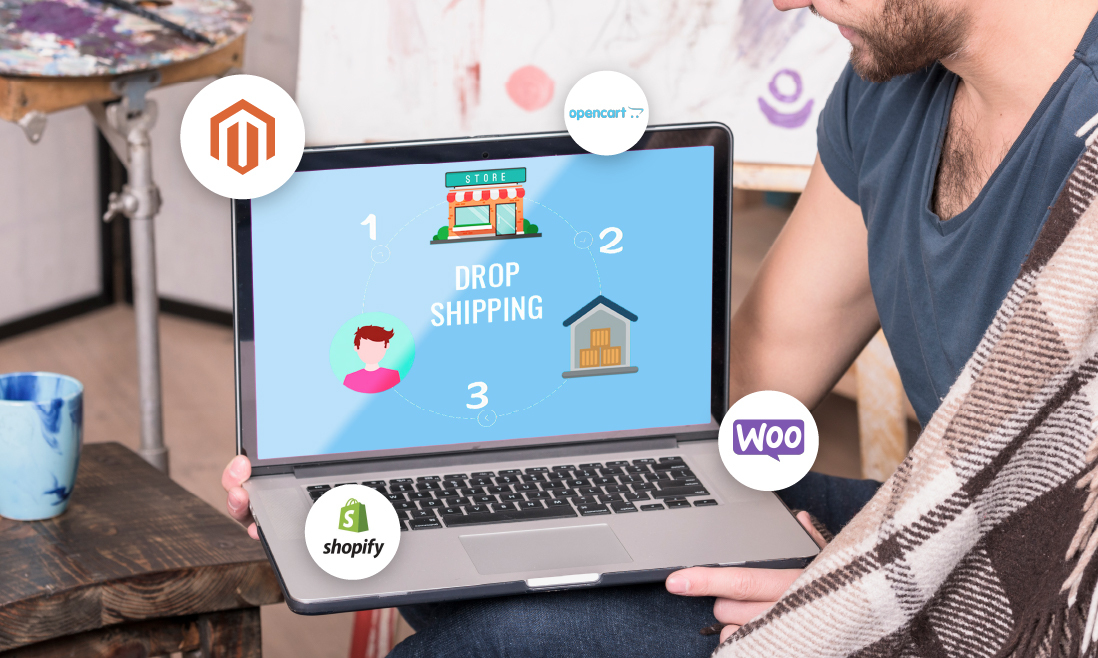The Ultimate Guide to Dropshipping Platforms for Newbie Entrepreneurs: Navigating Your Path to E-Commerce Success
Are you an aspiring entrepreneur looking to dip your toes into the world of e-commerce? Dropshipping might just be the perfect starting point for you. But with so many platforms out there, how do you choose the right one? Don't worry, we've got you covered! In this comprehensive guide, we'll explore the best dropshipping platforms for beginners and help you kickstart your online business journey.

Shopify: The All-in-One E-commerce Powerhouse
Shopify has long been a favorite among dropshippers, and for good reason. Its user-friendly interface and robust feature set make it an excellent choice for beginners.
Pros:
- Easy to set up and use
- Extensive app store with dropshipping-specific tools
- Built-in payment processing
- 24/7 customer support
Cons:
- Monthly fees can add up with premium apps
- Transaction fees unless using Shopify Payments
Many successful dropshippers swear by Shopify. For instance, Sarah Jones, a dropshipping coach, shared on LinkedIn: "Shopify was a game-changer for my dropshipping business. Its intuitive interface and powerful apps helped me scale from zero to six figures in just 18 months."
To get started with Shopify, check out their dropshipping guide for valuable insights and tips.
WooCommerce: The WordPress Plugin for Budget-Conscious Beginners
If you're familiar with WordPress and looking for a cost-effective solution, WooCommerce might be your best bet.
Pros:
- Free to use (you only pay for hosting)
- Highly customizable
- Large community and plugin ecosystem
Cons:
- Steeper learning curve for non-technical users
- Requires separate hosting and domain
- You're responsible for security and updates
WooCommerce is popular among DIY entrepreneurs. John Smith, a successful dropshipper, shared his experience on the WooCommerce community forums: "WooCommerce allowed me to start my dropshipping business on a shoestring budget. The flexibility is unmatched, and with a bit of patience, you can create a truly unique store."
BigCommerce: The Scalable Solution for Growth-Minded Entrepreneurs
BigCommerce offers a robust platform that can grow with your business, making it an excellent choice for beginners with big ambitions.
Pros:
- No transaction fees
- Built-in SEO features
- Multi-channel selling capabilities
- Abandoned cart recovery
Cons:
- Steeper learning curve than some competitors
- Limited free themes
BigCommerce has been gaining traction in the dropshipping community. As Emily Chen, a dropshipping consultant, tweeted: "BigCommerce's scalability is impressive. I've seen clients seamlessly transition from startup to enterprise-level without changing platforms."
For more insights on using BigCommerce for dropshipping, check out their comprehensive guide.
Wix: The Drag-and-Drop Wonder for Creative Entrepreneurs
If you're looking for a platform that allows you to create a visually stunning store with minimal technical know-how, Wix might be your perfect match.
Pros:
- Intuitive drag-and-drop editor
- Beautiful templates
- Built-in dropshipping app (Modalyst)
- Affordable pricing
Cons:
- Limited customization compared to some competitors
- Can be challenging to switch templates once your store is live
Wix has been making waves in the e-commerce space. As noted by David Lee on Facebook: "Wix's drag-and-drop editor is a godsend for creative entrepreneurs. I was able to create a professional-looking store in just a few hours, even with zero coding experience."
Learn more about dropshipping with Wix in their official guide.
Squarespace: The Design-Focused Platform for Brand-Conscious Beginners
If you're all about aesthetics and want your store to look sleek and professional from day one, Squarespace might be the platform for you.
Pros:
- Stunning, mobile-responsive templates
- All-in-one platform (hosting, domain, SSL included)
- Built-in SEO tools
- 24/7 customer support
Cons:
- Limited app integrations compared to competitors
- Can be pricier for advanced features
Squarespace has been gaining popularity among design-savvy dropshippers. Lisa Wang, a lifestyle brand owner, shared on Instagram: "Squarespace allowed me to create a beautiful, on-brand store that perfectly showcases my products. The templates are a dream for anyone who values aesthetics."
To explore Squarespace's e-commerce capabilities, check out their getting started guide.
Making Your Decision: Factors to Consider
Choosing the right dropshipping platform is a crucial decision that can impact your business's success. Here are some factors to keep in mind:
- Budget: Consider both short-term and long-term costs. While some platforms might seem cheaper initially, factor in the cost of necessary apps and features as your business grows.
- Technical Skills: Be honest about your technical abilities. If you're not comfortable with coding, a user-friendly platform like Shopify or Wix might be a better fit.
- Scalability: Think about your long-term goals. Choose a platform that can grow with your business.
- Product Niche: Some platforms integrate better with certain suppliers or product types. Research which platform works best for your chosen niche.
- Design Preferences: If having a visually stunning store is a top priority, consider design-focused platforms like Squarespace or Wix.
- Support and Community: Look for platforms with robust customer support and active user communities. These resources can be invaluable when you're just starting out.
Real-World Success Stories
To give you some inspiration, let's look at a few success stories from dropshippers who started on these platforms:
- Shopify Success: Mark Johnson started his pet accessories dropshipping store on Shopify in 2019. Within 18 months, he was generating over $50,000 in monthly revenue. Mark credits Shopify's ease of use and powerful marketing tools for his rapid growth.
- WooCommerce Win: Sarah Lee built her sustainable fashion dropshipping business using WooCommerce. She appreciated the platform's flexibility and low start-up costs. Today, her store generates over $100,000 in annual revenue.
- BigCommerce Breakthrough: Tom Smith chose BigCommerce for his electronics dropshipping store. The platform's scalability allowed him to expand from a small niche store to a multi-million dollar business without changing platforms.
- Wix Wonder: Emma Chen used Wix to create a dropshipping store for her custom phone case designs. The platform's design capabilities allowed her to showcase her products beautifully, leading to over $30,000 in monthly sales within a year.
- Squarespace Star: David Brown built a successful home decor dropshipping store on Squarespace. The platform's sleek templates perfectly complemented his premium product line, helping him achieve over $200,000 in sales in his first year.
Expert Tips for Dropshipping Success
Regardless of the platform you choose, here are some expert tips to help you succeed in your dropshipping venture:
- Focus on Niche Products: Neil Patel, a renowned digital marketing expert, advises: "Choose a specific niche and become an expert in it. This allows you to target your marketing efforts more effectively and build a loyal customer base."
- Prioritize Customer Service: Oberlo, a popular dropshipping app, emphasizes the importance of excellent customer service: "In dropshipping, where you don't control the product quality or shipping, outstanding customer service can set you apart from competitors."
- Invest in Quality Product Images: Shopify suggests: "High-quality product images can significantly boost your conversion rates. Consider investing in professional product photography or learning to take great photos yourself."
- Leverage Social Proof: BigCommerce recommends: "Use customer reviews, testimonials, and user-generated content to build trust with potential customers. Social proof can be a powerful conversion tool."
- Continuously Test and Optimize: Wix advises: "Regularly test different aspects of your store, from product descriptions to checkout processes. Small improvements can lead to significant increases in conversion rates over time."
FAQs About Dropshipping Platforms for Beginners
- Q: Do I need coding skills to use these dropshipping platforms? A: Not necessarily. Platforms like Shopify, Wix, and Squarespace are designed to be user-friendly and don't require coding skills. However, some knowledge of HTML and CSS can be helpful for customizing your store on platforms like WooCommerce.
- Q: Can I switch platforms later if I outgrow my initial choice? A: Yes, it's possible to switch platforms, but it can be a complex process. It's best to choose a scalable platform from the start to avoid the need for a major overhaul later on.
- Q: How much money do I need to start dropshipping? A: The initial investment can be relatively low, especially with platforms that offer free trials or low-cost plans. However, you should budget for platform fees, domain costs, and marketing expenses. A realistic starting budget might be around $500-$1000.
- Q: How do these platforms handle taxes for dropshipping? A: Most platforms offer built-in tax calculation tools, but the specifics can vary. It's important to consult with a tax professional to ensure you're complying with all relevant tax laws in your jurisdiction.
- Q: Can I use multiple suppliers with these dropshipping platforms? A: Yes, most of these platforms allow you to work with multiple suppliers. However, the ease of managing multiple suppliers can vary. Shopify and BigCommerce, for example, offer robust multi-supplier management tools.
Conclusion: Your Dropshipping Journey Begins Here
Choosing the right dropshipping platform is a crucial first step in your e-commerce journey. While each platform has its strengths, the best choice for you will depend on your specific needs, skills, and goals.
Remember, success in dropshipping isn't just about the platform you choose – it's about how you use it. Focus on providing value to your customers, continuously learning and improving, and staying adaptable in the ever-changing world of e-commerce.
Whether you opt for the user-friendly power of Shopify, the cost-effectiveness of WooCommerce, the scalability of BigCommerce, the design focus of Wix, or the sleek aesthetics of Squarespace, you're now equipped with the knowledge to make an informed decision.
So, what are you waiting for? Your dropshipping success story starts now. Choose your platform, set up your store, and embark on your entrepreneurial adventure. The world of e-commerce is waiting for you!





